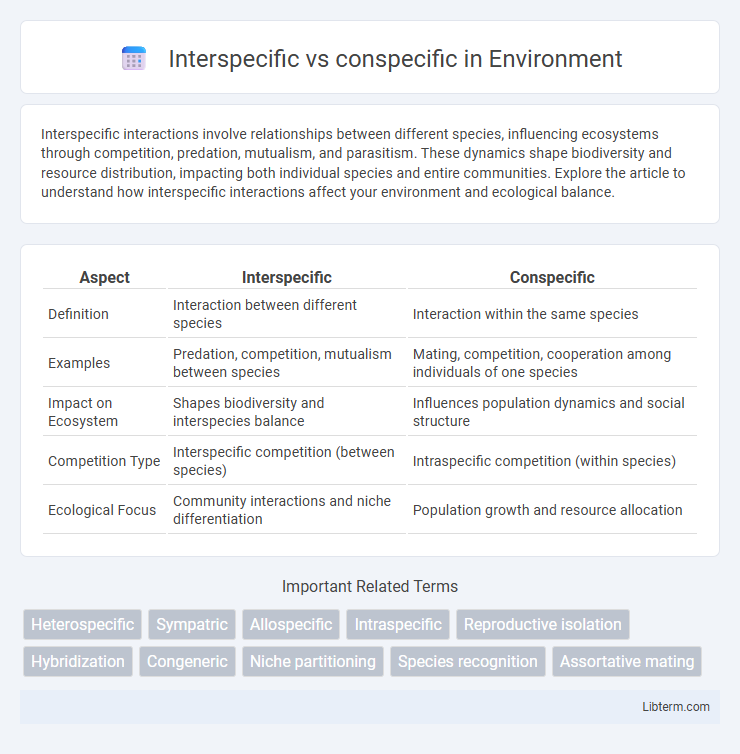Interspecific interactions involve relationships between different species, influencing ecosystems through competition, predation, mutualism, and parasitism. These dynamics shape biodiversity and resource distribution, impacting both individual species and entire communities. Explore the article to understand how interspecific interactions affect your environment and ecological balance.
Table of Comparison
| Aspect | Interspecific | Conspecific |
|---|---|---|
| Definition | Interaction between different species | Interaction within the same species |
| Examples | Predation, competition, mutualism between species | Mating, competition, cooperation among individuals of one species |
| Impact on Ecosystem | Shapes biodiversity and interspecies balance | Influences population dynamics and social structure |
| Competition Type | Interspecific competition (between species) | Intraspecific competition (within species) |
| Ecological Focus | Community interactions and niche differentiation | Population growth and resource allocation |
Understanding Interspecific and Conspecific Interactions
Interspecific interactions occur between different species and include competition, predation, mutualism, and parasitism, shaping community dynamics and ecosystem balance. Conspecific interactions involve individuals of the same species, influencing behaviors such as cooperation, mating, territoriality, and social hierarchy. Understanding these interactions provides insight into population regulation, species coexistence, and evolutionary adaptations within ecological systems.
Key Differences Between Interspecific and Conspecific Relationships
Interspecific relationships occur between individuals of different species, often involving competition, predation, or mutualism, while conspecific relationships happen within the same species, typically involving cooperation, mating, or social hierarchy. Interspecific interactions influence biodiversity and ecosystem dynamics, whereas conspecific interactions are critical for population stability and reproductive success. The distinction between these relationships is fundamental for understanding ecological balance and species evolution.
Examples of Interspecific Interactions in Nature
Interspecific interactions occur between individuals of different species and include examples such as predation, where lions hunt zebras, mutualism seen in pollination between bees and flowering plants, and competition for resources among different types of birds in a shared habitat. Other notable instances involve parasitism, like ticks feeding on deer, and commensalism, exemplified by barnacles attaching to whales without harming them. These interactions significantly influence ecosystem dynamics, species distribution, and evolutionary processes.
Examples of Conspecific Interactions in Nature
Conspecific interactions occur between members of the same species and often involve behaviors like cooperation, competition, and communication. Examples include wolf pack hunting strategies that enhance prey capture success, bird species engaging in cooperative breeding to increase offspring survival, and territorial disputes among lions that establish dominance hierarchies. These interactions influence social structure, resource allocation, and reproductive success within populations.
Impact on Evolution and Adaptation
Interspecific interactions, involving different species, drive evolutionary changes through mechanisms like competition, predation, and mutualism, promoting diverse adaptations and speciation. Conspecific interactions, occurring within the same species, influence evolution primarily via sexual selection, cooperation, and competition for mates, enhancing traits that improve reproductive success and social cohesion. Both types of interactions shape genetic variation and natural selection, but interspecific dynamics often lead to broader ecological diversification while conspecific interactions fine-tune species-specific adaptations.
Role in Ecosystem Dynamics
Interspecific interactions involve relationships between different species, such as predation, competition, and mutualism, which regulate population sizes and maintain biodiversity within ecosystems. Conspecific interactions occur among individuals of the same species, influencing social structure, mating systems, and resource allocation that affect population stability. Both types of interactions drive ecosystem dynamics by shaping community composition and resource distribution patterns.
Behavioral Patterns: Interspecific vs Conspecific
Interspecific behavioral patterns involve interactions between different species, often characterized by competition, predation, and mutualism, which influence ecosystem dynamics and species coexistence. Conspecific behaviors occur within the same species, including communication, mating rituals, and territoriality, which promote social cohesion and reproductive success. Understanding these patterns helps clarify how species adapt to environmental pressures and maintain population stability.
Importance in Conservation Strategies
Interspecific and conspecific interactions play crucial roles in shaping effective conservation strategies by influencing population dynamics, genetic diversity, and ecosystem stability. Understanding interspecific relationships, such as predation and competition, helps manage species coexistence and habitat requirements, while conspecific interactions inform breeding programs and social structure preservation essential for maintaining viable populations. Integrating these biological insights ensures targeted conservation efforts that enhance species survival and ecosystem resilience.
Challenges in Research and Identification
Interspecific research faces significant challenges due to the genetic and behavioral differences that complicate species boundaries, while conspecific identification struggles with subtle intraspecific variations that require precise morphological or genetic markers. Molecular techniques such as DNA barcoding and genomic sequencing are critical in distinguishing closely related species and categorizing individuals within the same species. Accurate identification is essential for ecological studies, conservation efforts, and understanding evolutionary processes, but variability in phenotypic traits often leads to misclassification and data inconsistency.
Conclusion: The Significance of Species Interactions
Interspecific interactions, occurring between different species, and conspecific interactions, happening within the same species, both play crucial roles in shaping ecosystems. These interactions influence biodiversity, population dynamics, and evolutionary processes by affecting resource competition, predation, and social behaviors. Understanding the balance between interspecific and conspecific relationships is essential for conservation strategies and ecosystem management.
Interspecific Infographic

 libterm.com
libterm.com